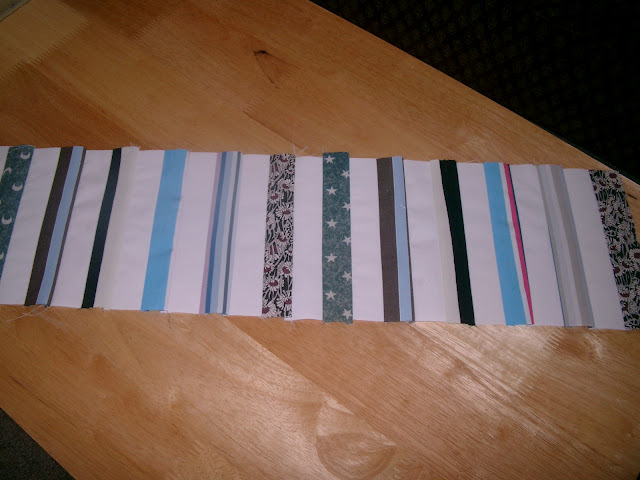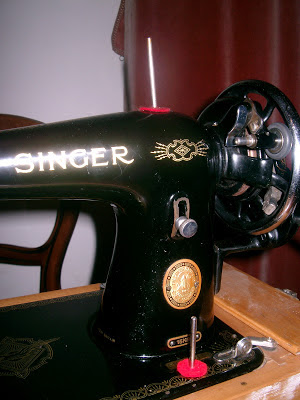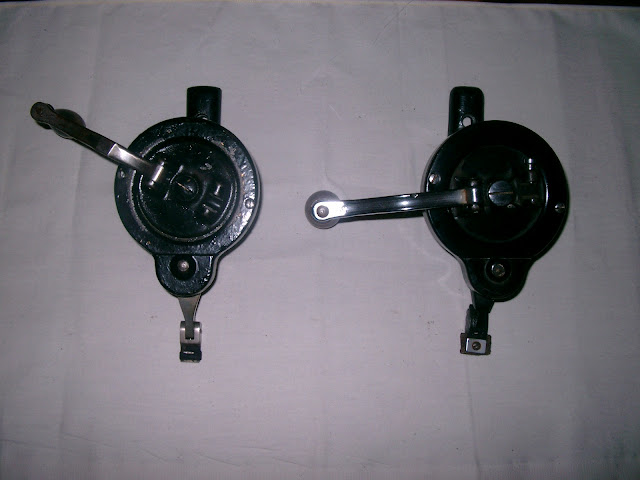"This cabinet is beautifully finished and, when closed, presents no suggestion of a sewing machine."
So said Singer when they were still trying to sell them. It is actually quite a good design and, although mine isn't in as new condition, it is well put together and the quality of the quarter cut veneer is as good as any mid 20th century factory made furniture I've seen. This one had been standing in a puddle in an out building when I collected it. It was cold and damp and had started to go mouldy and although the polish has flaked in places the carcass and veneer are basically sound. I let the cabinet gently dry out in an unheated room over the first few days of ownership. I haven't tried to wax it because I haven't decided whether I am going to strip and refinish part or all of the outside yet.

Here is the cabinet with both doors open revealing the treadle and flywheel. The polish on the inside is still sound and I wouldn't dream of messing with it. The box mounted on the inside of the left door is great. It's amazing how many attachments, bobbins, scissors, seam rippers and so on one can cram in there. The brown paint on the treadle irons is near perfect as is the rubber mat.
Nestling tantalisingly in the cabinet is the 201K. The top of the cabinet folds out to form a work surface which rests on the left hand cabinet door. This picture shows some of the battle scars the the cabinet has collected over the years very well.
There is strong-looking coil spring in the back of the cabinet which helps to counterbalance the weight of the machine when lifting it into the operating position. Venus approves of the large level working space to the left of the needle.
This 201K has the Plain-Jane "paper clip" decals and Johnny-Come-Lately striped face plate. It's all restrained elegance from post-war Kilbowie and I love it!
The serial number on this machine is from a batch allocated in 1950. Funny to think my 28K was already 50 years old when this 201K was brand spanking. I must admit that I do like the way the chrome really sparkles on this one. Amazingly it's none the worse for having been stored in a leaky shed.
 I include this picture of the machine lying in the well of the cabinet to show the striped access plate which matches the face plate and the round bracket fixed behind it. This must have been where the Singerlight attached to the machine. How handy would one of those be now?
I include this picture of the machine lying in the well of the cabinet to show the striped access plate which matches the face plate and the round bracket fixed behind it. This must have been where the Singerlight attached to the machine. How handy would one of those be now?
All I've really done here since getting the machine is clean, oil, recalibrate the tension indicator plate and fit a new bobbin tire. Rolls Royce sewing for less than the price of a yard of Liberty lawn tell that to a Viking Rep! Having been used to the 28K the 201K is a revelation. It really has to be heard to be believed. Sew quiet! The belt has started to slip a tiny bit since the machine became acclimatised to the sitting room but I've yet to pluck up the courage to shorten it. I am paranoid about making it too short and straining the bearings.
So far I've sewed a hobo bag for my mate Steph on the 201K and a patchwork cushion cover for T-M-B but I am looking forward to doing lots more with it. I really want to try and make a shirt for myself one day soon.








































